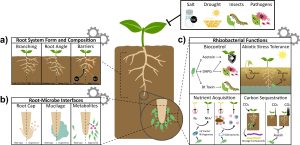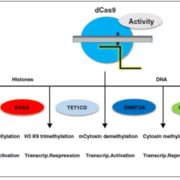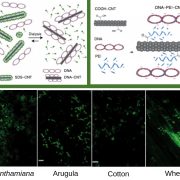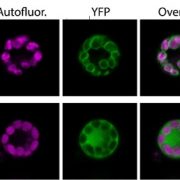Review: SynBio takes on roots and the rhizosphere
 This is an excellent introduction to how synthetic biology can be used to program plants for climate resilience by engineering them to respond predictably and in ways beyond those that evolution has explored, through the use of controllable synthetic gene circuits. Ragland et al. describe how precise and specific transcription factors can target synthetic promoter elements with little bleed-through to other genes, providing very fine and predictable control of gene expression and eliminating confounding pleiotropic effects. Combining these elements as Boolean logic gates can produce expression patterns in cells where conditions are absent (NOR gates) or NIMPLY gates where expression occurs where one circuit is on and the other off. After describing some of these synthetic gene circuits, the article discusses how they can be used to modify root system architecture, anatomy, and nutrient uptake. Several key genes have been identified with large impacts on root development, such as lateral root initiation or gravity setpoint angle, which in turn affect water and nutrient uptake. Genes that affect nutrient uptake, soil penetrance, and exudation of molecules into the soil are also promising candidates for synthetic biology-based engineering. Finally, plant productivity can be promoted by the potentially quicker engineering of soil microbes, with examples discussed that can impact plant biotic and abiotic interactions, as well as nutrient acquisition. Through the use of the design-build-test-learn cycle, its likely that we’ll be seeing rapid progress in the engineering of plant root systems. (Summary by Mary Williams @PlantTeaching) Nature Comms. 10.1038/s41467-024-45272-5
This is an excellent introduction to how synthetic biology can be used to program plants for climate resilience by engineering them to respond predictably and in ways beyond those that evolution has explored, through the use of controllable synthetic gene circuits. Ragland et al. describe how precise and specific transcription factors can target synthetic promoter elements with little bleed-through to other genes, providing very fine and predictable control of gene expression and eliminating confounding pleiotropic effects. Combining these elements as Boolean logic gates can produce expression patterns in cells where conditions are absent (NOR gates) or NIMPLY gates where expression occurs where one circuit is on and the other off. After describing some of these synthetic gene circuits, the article discusses how they can be used to modify root system architecture, anatomy, and nutrient uptake. Several key genes have been identified with large impacts on root development, such as lateral root initiation or gravity setpoint angle, which in turn affect water and nutrient uptake. Genes that affect nutrient uptake, soil penetrance, and exudation of molecules into the soil are also promising candidates for synthetic biology-based engineering. Finally, plant productivity can be promoted by the potentially quicker engineering of soil microbes, with examples discussed that can impact plant biotic and abiotic interactions, as well as nutrient acquisition. Through the use of the design-build-test-learn cycle, its likely that we’ll be seeing rapid progress in the engineering of plant root systems. (Summary by Mary Williams @PlantTeaching) Nature Comms. 10.1038/s41467-024-45272-5











